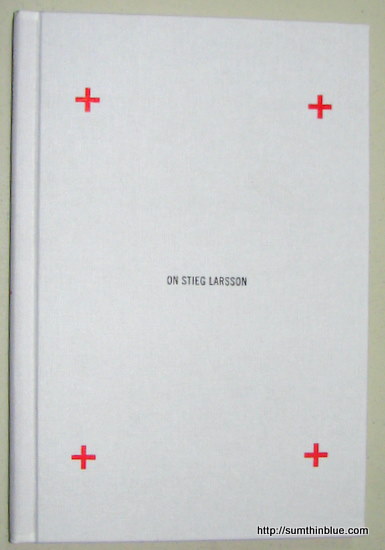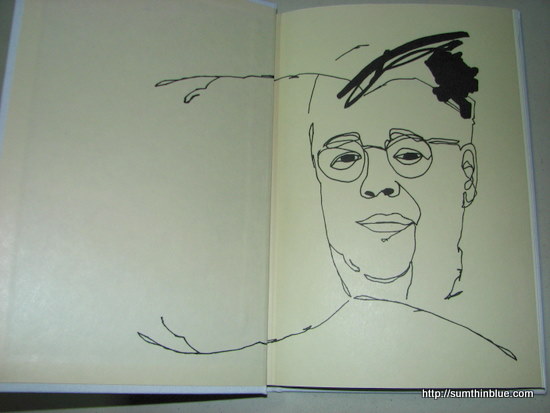As a belated Christmas present last year, I got myself the hardcover deluxe boxed set of Stieg Larsson’s Millennium Trilogy. Aside from the fact that it’s a breathtakingly beautiful set of cloth-covered books, I was pleased to find a fourth volume inside the slipcase: On Stieg Larsson.
After the exhilarating experience of reading the Millennium Trilogy, I was quite interested to find out more about Stieg Larsson, so I eagerly sank my teeth into this thin volume.
 On Stieg Larsson (trans. from Swedish by Laurie Thompson) is a collection of previously unpublished essays about the late author, as well as some of his correspondence.
On Stieg Larsson (trans. from Swedish by Laurie Thompson) is a collection of previously unpublished essays about the late author, as well as some of his correspondence.
Jonas Sundberg co-founded the Expo magazine with Larsson and a few others in 1995. In 1995, Larsson was among the group that founded Expo, which showcased investigative journalism against extremism, organized racism and anti-Semitism.
In the essay “Stieg,” Sundberg remembers Larsson as “a guy who preferred to work rather than be seen,” who was always willing to pitch in, but refused to be called editor in chief, and was always willing to take a step back when Expo was in the limelight.
He also narrates how Larsson would hammer away on his laptop until well past midnight, guessing that the bulk of the Millennium trilogy was written in the wee hours. Larsson had told Sundberg that he was writing a crime novel for his “pension insurance” and he appeared to be happy when he had “sold it for real money.”
Eva Gedin’s “Working with Stieg Larsson” is highly interesting, as it (along with the 20-page section of email correspondence that follows) gives us a better grasp of Larsson’s work process and personality. Gedin was Larsson’s first editor, and is publisher of the Fiction department of Norstedts Forlag.
She describes Larsson on their first meeting as “quite unassuming, dressed in jeans and a T-shirt, with lively eyes behind his glasses, an apparently friendly, nice, middle-aged Swedish man” and says she never thought he would come to mean so much to her and to countless readers all over the world.
Eerily, she also says, “Despite his somewhat reserved air, there was also a measure of natural self-assurance about him that suggested he had a premonition that his crime novels… might possibly become something truly significant.”
Gedin reveals that Larsson regarded the first three books as a coherent trilogy, and upon submission of the first two books — which the publishing firm was enthusiastic about — he was offered a three-book contract for both hardback and paperback editions, highly unusual, especially for an unpublished novelist.
They were planning their celebratory party after the German publisher Heyne (part of the Random House group) made a substantial bid for the books, but alas, Larsson passed away of a heart attack before they could get together.
“Stieg Larsson: The Un-Swedish Author” by John-Henri Holmberg, publisher of Sweden’s only science fiction magazine Nova (among other things, he’s also a book editor, publisher, author and contributor to books on sci-fi, fantasy, psychological suspense, and 20th century cinema) and a personal friend of Larsson (who was also a big sci fi fan), gives us a biographical essay that covers Larsson’s childhood, his writing, his military service, his journalistic experience, and his foray into fiction.
Holberg quotes an interview Larsson gave for the Svensk Bokhandel (Swedish book trade journal), which givescredence to the Lisbeth Salander – Pippi Longstocking parallel:
“I considered Pippi Longstocking and wondered what she would be like today. What kind of adult would she be? And what would people call a person like her? A sociopath? Hyperactive? Wrong. She simply sees society in a different light. I would make her twenty-five years old and an outcast. She has no friends and is deficient in social skills. That was my original thought.
The idea for a secondary character soon followed, inspired by another Astrid Lindgren character, Kalle Blomkvist:
…only now he’s forty-five years old and a journalist. An altruistic know it all who publishes a magazine called Millennium.
Holmberg also reveals Larsson had prepared an outline that covered up to ten novels AND apparently in their last email correspondence, the fourth novel was three-quarters finished and the fifth well begun! (Aieeeeeeee!)
He also gives a brief history of Swedish crime fiction and how Larsson’s novels broke the traditions not only of the genre but also Swedish attitudes and beliefs.
And I think Holmberg sums up Larsson’s writing prowess very well in this statement:
Stieg Larsson’s strength as a writer was neither impeccable prose nor stylistic experimentation. His prose was not impeccable and his style was pedestrian. He was a journalistic writer, prone to repetition, the occasional misplaced word, the occasional misspelling, the occasional pedantic enumeration. The vividness of his novels is not linguistic but a matter of evocativeness: his clear visualization of characters, his sheer storytelling talent. If anything, his novels are an illustration of the idea that a good enough storyteller is able to transcend the limitations of his style.
He closes with a narration of the events of the tragic day Larsson died, when he arrived at work pale and short of breath, and momentarily collapsed. His last words, as he was being revived in an ambulance and paramedics were asking him the year, his name and his age, were,
“I’m fifty, damn it!”
Finally, Steve Weyler, publishing director of Norstedts before he put up his own publishing house Weyler Forlag, writes about the events after Larsson’s death in “The Stieg Larsson Phenomenon”: the legal battle over his estate (family vs. partner Eva Gabrielsson) and how tourists are flocking to Sweden to look for Lisbeth Salander. On a closing note, he mentions the fuss over the casting for the American version of the films, which he deems completely unnecessary:
Lisbeth S. exists already — in three versions: Stieg Larsson’s, every individual reader’s, and Noomi Rapace’s brilliant interpretation of this melancholy angry woman.
And every time you look her in the eye, you understand the real answer to the question of what turned Stieg Larsson’s three Swedish novels into a matter of concern to the whole wide world: Lisbeth Salander.
It is for her sake that tourists flock to Stockholm. But they will never set eyes on her. Not because she does not exist, but because she does not like tourists.
On Stieg Larsson is a wonderful wrap-up to the Millennium trilogy, and a must-read for all fans of the series. This book was a short but engrossing read for me, and I like how there are various perspectives — some of the same events — offered in this book, giving us a more balanced glimpse into Stieg Larsson as a person, a friend, a colleague, and a writer.
I also loved that there was a whole section of correspondence written by Larsson himself, wherein he talks about the books and how he pieced them together — it’s always fascinating to read about the creative process of a favorite author.
I wish there were photos in the book, although I understand that there were security issues given the nature of his work, hence there are few photos of him available today. But yeah, I’d have devoured photos of the manuscripts, Sweden, the Expo offices, his favorite coffee shop, and other ephemera all the same.
There is, inevitably, some amount of wistfulness that comes from reading this book, as it all the more underscores what the rest of the Larsson fandom wishes could have happened: that he lived longer to flesh out his ten-novel outline. But sigh, life is short, and we make do with what we have. I can only hope they release the 4th novel (and his notes on the rest) in the future.
***
If you haven’t read the Millennium trilogy and would like to win a copy, join my Millennium Trilogy Giveaway! Only a few more days to go!
***
On Stieg Larsson, deluxe hardcover (4th volume in the Millennium Trilogy Deluxe boxed set, P2995 at National Book Store), 4/5 stars
Book #15 for 2010
[amazonify]::omakase::300:250[/amazonify]




It’s a shame Larsson had an untimely death. I know I would have devoured all 10 books in the Millennium series.
Same here :) I would have been happy to lose more sleep over the Millennium trilogy
Is this something that’s sold separately? I just finished the trilogy and I’m hoping there will be a 4th book. :D
As far as I know, it’s only sold as part of the deluxe set…
Wow! What a nice review! Right now I still envy your Millennium Trilogy deluxe slipcase edition. Please God, let that NBS Price Cut Sale be near!
On another note, yes, Larsson is a big fan of science fiction. I read somewhere that his Sweden publisher is looking into a science fiction novel he wrote before writing the Millennium Trilogy. I just can’t recall where I read that.
Again nice review Blooey!
Happy reading! ^_^
Only a few months to go for the cut-price sale, jzhun :)
I hope a 4th and the 5th book get published…so we can find out a bit more about……
SPOILER SPOILER SPOILER SPOILER
SPOILER (camilla) SPOILER SPOILER
Bwahahaha! Good one.
I wonder what she’s like.
This sounds really interesting! I loved the Millenium Trilogy and so did my husband. Funny, it sounds like Blomquist was based on Larssen’s own life with Expo!
Sue
I know right? :D Actually before I read this book, I was beginning to think his death was a conspiracy, like some people have surmised, but the essays in this book debunk that theory.